A Globally Harmonized System (GHS)
This page contains reference information regarding the Globally Harmonized System (GHS) plan including glossaries, procedures, and infographics.
- The revised OSHA Hazard Communication Standard
- Compliance Phase-In
- Major changes to the Hazard Communication Standard
- Keywords (Terminology)
- GHS Classification
- Physical Hazards
- Health Hazards
- Environmental Hazards
- Categories
- GHS Label Elements
- Hazard Pictograms
- Signal Words and Hazard Statements
- Precautionary Statements
- GHS & Transport Label Placement
- Confidential Business Information (CBI)
- Safety Data Sheets - SDS
- OSHA / GHS Differences
- Labeling Options - Secondary Labels focus at AU
- Right To Understand
- Encountering Hazardous Substances in the Workplace
- Requirements of the Standard
- The Law
- What is a Hazardous Substance?
- Informing of Hazards
- OSHA Recommendations
- Prior to Purchasing Chemicals
- Routes of Entry
- Chemical Safety – Alfred University Policy
- Common Sense Safety
- Physical Characteristics of Airborne Substances Gases, Vapors, Fumes, Dusts, Mists, & Smoke
- Council on Green Efforts @ AU
- Containers and Labeling
- EHS Exposure Monitoring
- MSDS Online at Alfred University
- Housekeeping - Alfred University Policy
- Preparedness - Alfred University Policy
- Emergency Response Information
- Alfred University Accident Report
- Contact Information
The revised OSHA Hazard Communication Standard
Compliance Phase-In
The table below summarizes the phase-in dates required under the revised Hazard Communication Standard (HCS)
| Effective Completion Date | Requirement(s) | Who |
|---|---|---|
| December 1, 2013 | Train employees on the new label elements and safety data sheet (SDS) format. | Employers |
| June 1, 2015 December 1, 2015 | Compliance with all modified provisions of this final rule, except: The Distributor shall not ship containers labeled by the chemical manufacturer or importer unless it is a GHS label | Chemical manufacturers, importers, distributors, and employers |
| June 1, 2016 | Update alternative workplace labeling and hazard communication program as necessary, and provide additional employee training for newly identified physical or health hazards. | Employers |
| Transition Period to the effective completion dates noted above | May comply with either 29 CFR 1910.1200 (the final standard), or the current standard, or both. | Chemical manufacturers, importers, distributors, and employers |
Major changes to the Hazard Communication Standard
Hazard classification
Chemical manufacturers and importers are required to determine the hazards of the chemicals they produce or import. Hazard classification under the new, updated standard provides specific criteria to address health and physical hazards as well as classification of chemical mixtures.
Labels
Chemical manufacturers and importers must provide a label that includes a signal word, pictogram, hazard statement, and precautionary statement for each hazard class and category.
Safety Data Sheets
The new format requires 16 specific sections, ensuring consistency in presentation of important protection information.
Information and training
To facilitate understanding of the new system, the new standard requires that workers be trained by December 1, 2013 on the new label elements and safety data sheet format, in addition to the current training requirements.
Keywords (Terminology)
Class the hazard or hazards assigned to a product, or inherent properties, which are identified as physical, health, and environmental.
Category the degree of danger represented by the hazard of a particular product, these range from category 1, great danger to category 5, low danger.
Product Identifier chemical name or trade name or proper shipping name.
Safety Data Sheet (SDS) analogous to MSDS in the U.S. These are sheets or a booklet that describe the hazards of the product, and give details about safe handling and responding to emergencies.
Pictogram the symbol or sign used to identify the class (hazard(s)) assigned to a product on the warning label. There are 9 pictograms.
Signal Word is the word Danger or Warning that will appear as part of the warning label. Indicates the degree of hazard the product possesses.
Hazard Statements are standardized statements that will appear as part of the hazard communication system identifying just what hazards the user should be aware of.
Precautionary Statements are standardized statements (and/or pictogram) which describe recommended measures that should be taken to minimize adverse effects resulting from exposures to a hazardous product, or improper storage or handling of a hazardous product.
GHS Classification
Three basic classes of hazards:
Physical - e.g. flammability or reactivity
Health - immediate and long-term toxicity
Environmental - toxicity to aquatic organisms, potential to bio accumulate or persist in the environment, and things hazardous to the ozone layer.
Physical Hazards
- Explosives
- Flammable Gases
- Flammable Aerosols
- Oxidizing Gases
- Gases under pressure
- Flammable liquids
- Flammable solids
- Self-reactive substances - thermally unstable and may break-down when heated
- Pyrophoric liquids and solids - ignite spontaneously at room temperature or below
- Self-heating substances - react with oxygen and start to burn
- Water-reactive substances
- Oxidizing liquids and solids - cause ignition of other materials by chemical reaction or increase the heat and speed of a fire
- Organic peroxides - oxidizers with a special chemical structure that tends to make them unstable
- Corrosives - corrosive to metal (acids or bases)
Health Hazards
Acute Toxicity (immediate hazard)
- Immediate toxicity - immediate and serious health effects possibly including death on exposure
- Corrode or burn skin and eyes
- Irritation (significant) to skin and eyes
- Carcinogenicity - cancer causing
- Germ cell mutagenicity - cause mutations or genetic change to germ cells in the body
- Reproductive toxicity - reproductive effects, e.g. birth defects or sterility
- Skin/Respiratory sensitization - things which can cause allergic reactions to the skin or respiratory system on exposure
- Target organ effects - certain chemicals can attack certain parts of the body either on a single exposure or repeated exposure (e.g. prolonged exposure to asbestos (lungs), many dry-cleaning chemicals attack the liver and kidneys even after a single exposure)
- Aspiration hazards - materials entering the lungs which cause a serious inflammation called pneumonitis which can be fatal; many petroleum based products and solvents may be aspiration hazards.
Environmental Hazards
- Existing IMDG (International Maritime Dangerous Goods Code) Marine Pollutant criteria
- European Union criteria used in ADR/RID transportation regulations:
- ADR = Agreement on Dangerous Goods by Road
- RID = Regulations concerning the International Transport of Dangerous Goods by Rail
- U.S. EPA hazardous substance criteria
- Materials which are hazardous to the ozone layer
- Aquatic hazards (Acute and/or Chronic toxicity)
- Bioaccumulation - toxins accumulate faster than they can be eliminated
Categories
Categories 1 through 5 - similar to transportation packing group
- Category 1 - most hazardous
- Category 5 - least hazardous (only hazardous to vulnerable segments of population, e.g. small children or people with compromised immune systems)
Categories may be further sub-divided, e.g. Category 1A, 1B, 1C, etc. Explosive hazards are designated by “divisions”. The less dangerous categories may not be regulated in all modes in all countries.
| Exposure Route | Category 1 | Category 2 | Category 3 | Category 4 | Category 5 |
|---|---|---|---|---|---|
| Oral (mg/kg bodyweight) | 5 | 50 | 300 | 2000 | 5000 |
| Dermal (mg/kg bodyweight) | 50 | 200 | 1000 | 2000 | 5000 |
| Gases (ppmV) | 100 | 500 | 2500 | 5000 | 5000 |
| Vapors (mg/l) | 0.5 | 2 | 10 | 20 | 5000 |
| Dusts and Mists (mg/l) | 0.05 | 0.5 | 1.0 | 5 | 5000 |
Note: A very small amount, 0-5 mg/kg of bodyweight (oral), of an acutely toxic substance yields an LD50 (the lethal dose kills 50 % of the tested population). This results in assigning a Category 1 - most hazardous designation. (Example: Cyanide - http://en.wikipedia.org/wiki/Cyanide)
GHS Label Elements
- Product Identifier (chemical name or trade name or proper shipping name – no chemical formulas, list hazardous ingredients where appropriate)
- Chemical Identity (Chemical Abstracts Service[CAS] # if applicable) - optional on secondary labels
- Hazard pictogram(s) - one or more
- Signal word - either DANGER or WARNING
- Hazard statement(s)
- Precautionary information - optional on secondary labels
- Supplier Identifier (supplier information, e.g.name, address, phone, etc.)
Classification (class and category) drives labeling. Information should be conveyed in more than one way, both symbols and text.
GHS Standardized Elements:
- Symbol (Hazard Pictogram)
- Signal Word
- Hazard Statements
- Precautionary Statements
Hazard Pictograms
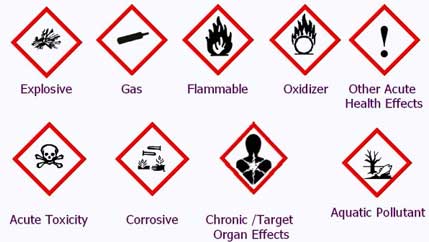
Signal Words and Hazard Statements
Signal Words
Only two words are used, “Danger” or “Warning”, to emphasize the hazard and differentiate between the degrees of hazard. Danger is used for higher hazard materials, and Warning for lower level hazards. The use of one word excludes the use of the other.
Hazard Statement
GHS assigns a single harmonized statement for each level of hazard within each hazard class. See Annex 3 - Section 1, of the Globally Harmonized System of Classification and Labeling of Chemicals (2011) Fourth Revised Edition. Example below:
Example: Flammable liquids
- Category 1: Extremely flammable liquid and vapor
- Category 2: Highly flammable liquid and vapor
- Category 3: Flammable liquid and vapor
- Category 4: Combustible liquid
Note: Another useful reference is Annex 1 "Allocation of Label Elements". This resource includes the label pictogram, signal word, hazard statement, and the UN Model Regulation pictogram and information.
More on Hazard Statements
Hazard Statements: phrase assigned to a hazard class and category which describes the nature of the hazard. Each statement will uniquely express the hazardous product, including, where appropriate, the degree of hazard.
FAQ
What does a Hazard Code look like?
- Each statement has a specific code associated in order to properly reference.
- Codes will begin with a H followed by a 3 digit code "H###"
Where can I find further information on the different types of Hazard statements?
- Section 1 of Annex 3 of the GHS
Do I need to apply both hazard statement and code when creating a Label?
- No. When creating a label, it is only required that the hazard statement is located on the packaging, hazard codes are optional.
What are the requirements for hazard statements when preparing a SDS?
- When preparing a SDS both Hazard statements and codes are required
- e.g. "H224: Extremely flammable liquid and vapor"
- e.g. "H290: May be corrosive to metals"
Precautionary Statements
This element is not yet mandatory in the U.S. as of Jan 2013. Mandatory or recommended inclusion of precautionary statements on the label will be left up to the individual country. Annex 3 - Section 2 discusses the codification and use of precautionary statements.
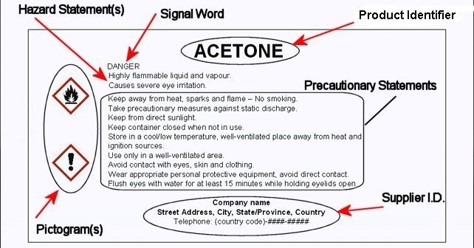
Note: Only those label elements identified with a red arrow are currently required under the GHS labeling system. The chemical or product/trade name serves as the product identifier and one should identify the hazardous ingredients where appropriate.
GHS & Transport Label Placement
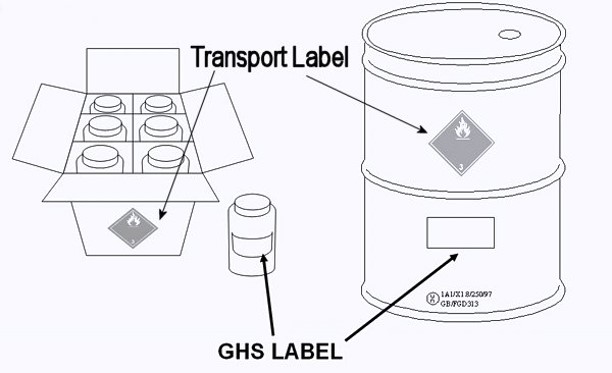
Confidential Business Information (CBI)
- CBI exemptions will not be harmonized under GHS (control left to individual countries)
- Provisions for CBI should not compromise the health and safety of users
- Non-disclosure names should be limited to the names of chemicals and their concentrations in mixtures
- Mechanisms should be established for disclosure in emergency and non-emergency situations (Manufacturer emergency # or CHEMTEC)
Safety Data Sheets - SDS
The SDS will provide comprehensive information about a chemical substance or mixture, including:
- Composition
- Major Hazards
- Safe Handling
- Emergency Response
GHS referenced standards, include but not limited to, to assist in SDS preparation:
Section 1: Identification
- Identification of the substance or mixture:
- GHS product identifier
- Other unique identifiers
- Supplier's details:
- Name, full address and phone number(s)
- Recommended use of the chemical and restrictions on use; and
- Emergency phone number
Section 2: Hazard Identification
- Classification of the substance or mixture
- GHS labels, including hazard and precautionary statements
- Other hazards which do not result in classification
Section 3: Composition/information on Ingredients
- Substances:
- Chemical identity
- Common name, synonym of the substance
- CAS number and other unique identifiers
- Impurities and stabilizing additives
- Mixtures (for all hazardous ingredients):
- Chemical identity
- Identification number
- Concentration range
Section 4: First-aid Measures
- Description
- Most important symptoms/effects, acute and delayed
- If needed, indication of:
- Immediate medical attention
- Special treatment
Section 5: Fire-fighting Measures
- Suitable extinguishing media
- Specific hazards arising from the chemical
- Special protective equipment and precautions for fire-fighters
Section 6: Accidental Release Measures
- Personal precautions, protective equipment and emergency procedures
- Environmental precautions
- Methods and materials for containment and cleaning up
Section 7: Handling and Storage
- Precautions for safe handling
- Conditions for safe storage (including incompatibilities)
Section 8: Exposure Controls/Personal Protection
- Control parameters
- Appropriate engineering controls
- Individual protection measures, including personal protective equipment (PPE)
Section 9: Physical and Chemical Properties
- Appearance
- Odor
- Odor threshold
- pH
- Melting point/freezing point, Initial boiling point and boiling range
- Flash point
- Evaporation rate
- Flammability (solid, gas, upper/lower flammability or explosive limits)
- Vapor pressure
- Vapor density
- Relative density
- Solubility( ies)
- Partition coefficient n-octanol/water
- Auto-ignition temperature
- Decomposition temperature
- Viscosity
Section 10: Stability and Reactivity
- Reactivity
- Chemical stability
- Possibility of hazardous reactions
- Conditions to avoid
- Incompatible materials
- Hazard decomposition products
Section 11: Toxicological Information
- Provide data for all the health hazards covered by the GHS.
- If data for any of those hazards is not available, they should be listed on the SDS with a statement
- that data is not available
- Information on the likely routes of exposure
- Symptoms related to the physical, chemical and toxicological characteristics
- Delayed and immediate effects and chronic effects from short or long term exposure
- Numerical measures of toxicity (such as ATE)
- Interactive effects
- Where specific chemical data are not available
- Mixtures
- Mixture versus ingredient information
- Other relevant information
Section 12: Ecological Information
- Toxicity
- Persistence and degradability
- Bioaccumulative potential
- Mobility in soil
- Other adverse effects
Section 13: Disposal Considerations
- Disposal methods
- Rules and regulations regarding disposal
Section 14: Transport Information
- UN Number
- UN Proper Shipping Name
- Transport hazard classes
- Packing group, if applicable
- Environmental hazards
- Special precautions for user
- Transport in bulk according to Annex II of MARPOL 73/78 and the IBC Code
Section 15: Regulatory Information
- Regulatory information not provided elsewhere in the SDS
- Safety, health and environmental regulations specific for the chemical in question
Section 16: Other Information
- Date of preparation of the latest version of the SDS
- Clear indication of the changes made to the previous revision
- Key/legend to abbreviations and acronyms used in the SDS
- Key literature references and sources for data used to compile the SDS
Example Safety Data Sheet
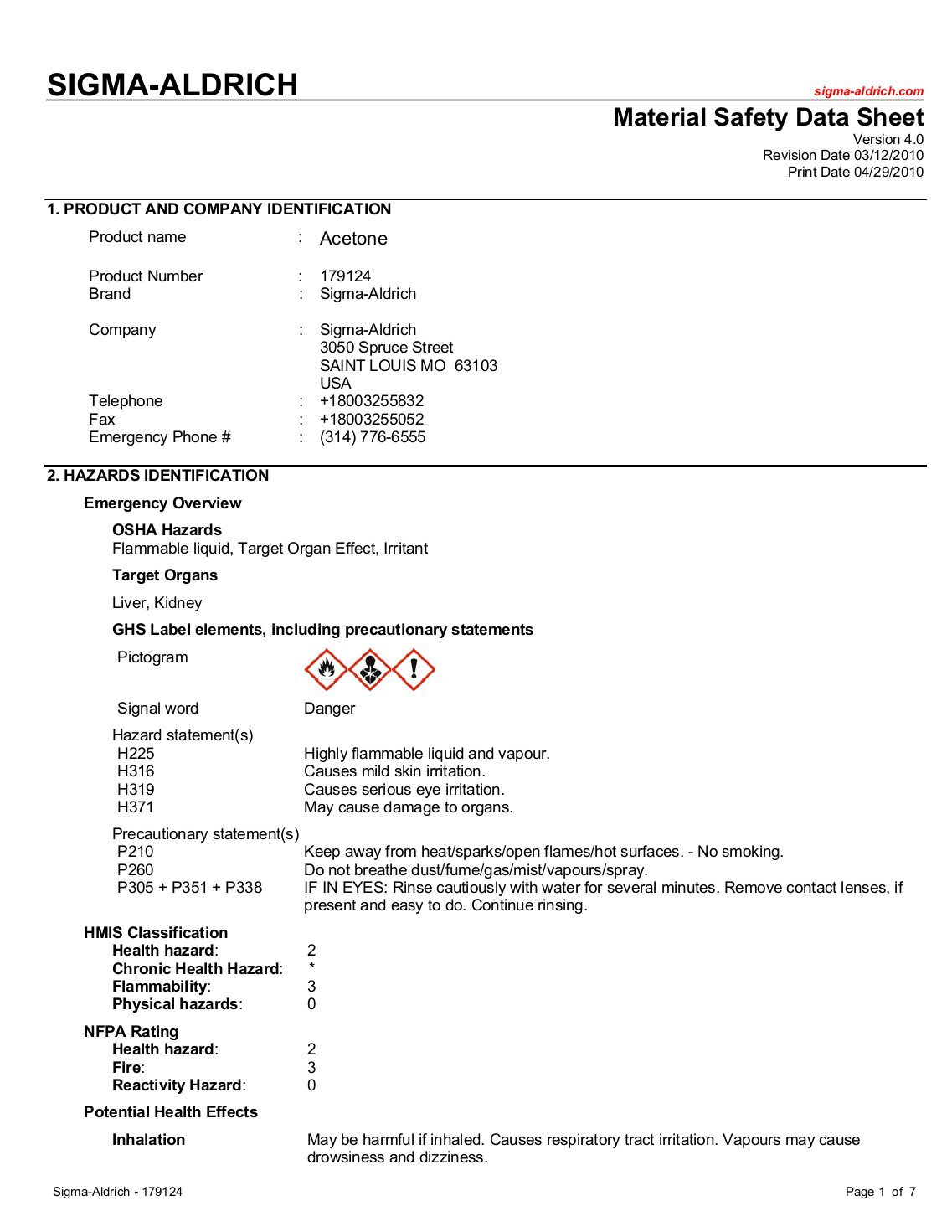
OSHA / GHS Differences
OSHA will not regulate:
- Non-health related hazards such as environmental hazards
- Acute toxic hazards in Category 5
- Skin corrosion/irritation hazards in Category 3 or higher
- Aspiration hazards in Category 2 or higher
Differences in cut-offs - OSHA new category "Unclassified Hazard" to cover hazards originally included in the OSHA standard but not included in the GHS.
U.S. Department of Transportation:
US DOT harmonization with GHS has already been completed.
Labeling Options - Secondary Labels focus at AU
- Standard Avery label on EHS Website, pictograms contact EHS
- MSDS Online (Site Administrators only)
- From original container (on color copier)
- Black border pictogram is okay for domestic purposes, red border required for overseas transport
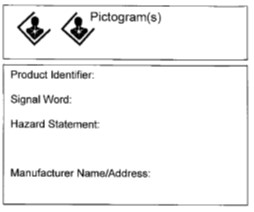
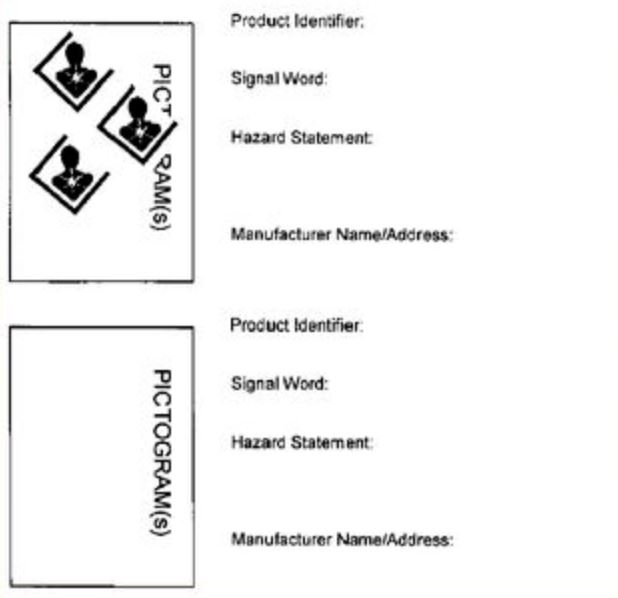
Obstacles:
- Secondary Labeling - Interpretation of SDS’s until all are compliant
- Manufacturer’s delay in generating GHS compliant SDS - some are going to wait until the last minute!
Right To Understand
Encountering Hazardous Substances in the Workplace
- Washing or filling a vehicle with gasoline or oil
- Cleaning and disinfecting
- Applying herbicides, pesticides, or insecticides
- Using solvents, acids, bases, flammables, and re-actives
- Using personal hygiene and cosmetic products
- Painting, wood working, and metal working
- Making or using ceramics and clays
- Using various office products (e.g. toners, inks, etc.)
- Barbecuing on a grill
- Plumbing, electrical, carpentry, and grounds work
Requirements of the Standard
- Inform you about the hazards in your work area
- Make Safety Data Sheets accessible to everyone and ensure they know how to use them and where they are located
- Ensure containers are labeled and that everyone knows how to read those labels
- Provide a written program, (located in 117 Myers Hall EH&S Office).
The Law
- OSHA/PESH – Employees, employers, students, Hazard Communication - 29 CFR 1910.1200, respiratory protection, personal protective equipment (PPE), etc.
- EPA - "cradle to the grave", containment, storage and disposal
- DEC - water, soil, and air contamination
- Other Government Agencies - DOH (health), FDA (food and drugs), NFPA (fire)
What is a Hazardous Substance?
- A hazardous substance includes, (but is not limited to), products that are toxic, corrosive, flammable, reactive, irritants, oxidizers, sensitizers, explosives, or radioactive
- The key question to ask is, "Do these materials create an unusual health or safety risk through their use or storage?"
- If the answer is yes, the material is likely hazardous
Note: The definitions and criteria of the hazards of a substance can be found in the Globally Harmonized System Revision 4 2011 edition. Physical hazards are found in Part 2, health hazards are found in part 3, and environmental hazards are found in part 4.
Informing of Hazards
- Signs - signage will inform you of hazards in your work area, especially signs containing words like danger, warning, notice, etc.
- Labels - label information should include the product or chemical name/identifier (never use a chemical formula), signal word, pictogram(s), hazard statement(s), and manufacturer name, address and phone number
- Safety Data Sheet (SDS) - required by law for all manufacturers to prepare
OSHA Recommendations
OSHA recommends that employers offer the following prevention strategies (listed in order of OSHA priority):
Engineering controls eliminate or reduce exposure to a chemical or physical hazard through the use or substitution of engineered machinery or equipment. Examples include self-capping syringe needles, ventilation systems such as a fume hood, sound-dampening materials to reduce noise levels, safety interlocks, and radiation shielding.
Administrative controls (or work practice controls) are changes in work procedures such as written safety policies, rules, supervision, medical surveillance, and training with the goal of reducing the duration, frequency, and severity of exposure to hazardous chemicals or situations.
Personal Protective Equipment (PPE) such as safety glasses with side shields, splash goggles, face shields, chemical resistant gloves, hard hats, rubber aprons, safety shoes, respirators, & hearing protectors must be worn when required, and maintained in good condition. The employer is responsible for providing proper PPE to the employee (this does not apply to students in classes or labs).
Prior to Purchasing Chemicals
- Check your chemical inventory (NOTE: chemical inventories are due to EH&S by June 15th annually)
- Contact EH&S to see if a surplus exists for what you need
- Obtain and read the SDS for the chemical
- Know the hazards of the chemical
- Make sure you have a safe way to use and store the chemical
- Know how to dispose of the chemical
Routes of Entry
In order of most common to least common: Inhalation, Absorption, Ingestion, Injection
Bodily Effects
- Acute
- Chronic
- Cumulative
- Non-cumulative
- Multiple exposures
- Toxins
- Sensitizers
- Allergens
Factors that affect the degree of hazard from toxic materials
- Amount of material
- Conditions of exposure
- Length and frequency
- Toxicity
- Total body burden
- Multiple exposures
- High risk groups
Chemical Safety – Alfred University Policy
Attire:
- Long sleeves and long pants
- Lab coat
- Close-toed shoes
- Eye protection is REQUIRED
- Do not wear contact lenses
- Secure long hair and loose clothing
- Wear appropriate gloves
Common Sense Safety
- Practice sensible, safe work habits
- Understand the Hazard Communication Standard and how it affects you and your co-workers
- Identify the hazardous materials you work with and protect yourself against them
- Understand what an SDS is, how to use it and where to find it
- Understand and utilize our labeling system
- Post emergency numbers by phone
- Know where safety equipment is located
- Make sure safety equipment is available, not covered or surrounded by clutter
- Keep aisles clear to the eye wash, shower, and emergency exits
- Check safety equipment and materials weekly to ensure they work
Physical Characteristics of Airborne Substances Gases, Vapors, Fumes, Dusts, Mists, & Smoke
COMPRESSED GAS - Any gas, mixture of gases, or liquids in a container having a pressure or vapor pressure exceeding ANSI Standards.
The following precautions must be used when handling:
- Valve protector caps must always be in place on cylinders when they are in storage or during transportation
- Use a cylinder cart when transporting, even for a short distance
- Compressed gas cylinders shall be properly stored, segregated, transported, and utilized in an upright position and anchored with a chain or other device
- Cylinders shall be stored in a well ventilated area away from flames, sparks or any source of heat or ignition
- Stored "Oxygen" cylinders, (empty or full), shall be separated from fuel gas cylinders and combustible materials
- When gases of different types are stored at the same location, cylinders must be grouped by types of gas, e.g., flammable gases must not be stored near oxygen
- When compressed cylinders are empty, they must be labeled, "Empty"
Council on Green Efforts @ AU
- Purchase/use only enough for an experiment, a semester or academic year
- Purchase the least hazardous product for the job
- See what others have on campus before buying using MSDS Online
- Recycle/reuse wherever possible
- Educate yourself on the green efforts programs at AU and the many ways we can reduce our carbon footprint.
- For an easy way to keep up with all things green here at AU, follow our efforts on facebook.
Containers and Labeling
- All containers must be properly labeled, always regard an unlabeled container as dangerous
- If the original label is illegible or you are transferring contents to an empty container, use the GHS secondary label available from EH&S
- Do not deface manufacturer’s original label unless container is completely empty
- Do not use food containers to store hazardous products or chemicals
- Use only compatible and approved containers to store hazardous products and chemicals
- Do not eat, drink, or apply cosmetics wherever chemicals are used or stored
Safety Data Sheet (SDS)
Exposure Situation
- First aid measures - what to do if you are exposed to the chemical
- Fire fighting measures - important information about dealing with fire, smoke and explosion
- Accidental release measures - procedures to be followed in an emergency spill or leak
Hazard Protection/Prevention
- Handling and storage information
- Engineering controls
- PPE
- Physical and chemical properties
- Stability or instability
- Conditions or materials that cause reactions
- Hazardous substance released if material decomposes
Other Specific Information
- Toxicological
- Ecological
- Disposal
- Transportation
- Regulatory Information
EHS Exposure Monitoring
- In-house lab testing - used only for general identification of unknowns
- Certified lab testing - required by law, i.e. sumps, Foster Lake, areas of suspected exposures, etc.
- QRAE II Portable 4 gas detector - confined space and air monitoring
- MSA personal air sampling pumps - we have 2 portable pumps which may be used either as stationary samplers or worn for personal sampling
- Sound level meter - for noise monitoring
- VelociCalc - Meter for measuring exhaust hood velocity
MSDS Online at Alfred University
All safety data sheets for Alfred University can be found on the internet at MSDS. Please use the link for instructions and access to the site.
If your work area or laboratory does not have access to a computer, a hard copy of all SDS’s in a 3-ring binder must be maintained in addition to the electronic copy. Supervisors are responsible for assigning an MSDS Online site administrator, and notifying EH&S when a new site administrator has been assigned. EH&S will train MSDS Online site administrators utilizing both online and individual training.
It is the employee's responsibility to read, understand and follow the information provided by an SDS for any hazardous material they may use or come in contact with.
Housekeeping - Alfred University Policy
- Manage chemicals properly
- Clean up after yourself after every use
- Keep all lab benches free from clutter, and put things back where you found them
- Do Not store ANYTHING in fume hoods
- Keep equipment away from shelf and bench edges
- Keep shelving orderly (do not store within 18 inches of ceiling)
- Keep an access path of at least 3 feet at all times
Preparedness - Alfred University Policy
Ensure your work area/lab has the following safety devices/systems:
- Telephone - with emergency numbers posted
- First aid kit
- Fire extinguisher
- Fire alarm pull station
- Eye wash (if required)
- Shower (if required)
- Chemical spill kit (if required)
- SDS’s readily available
Emergency Response Information
An Emergency Response information folder has been published by Alfred University providing detailed information relating to emergencies and non-emergencies. A copy of this folder may be obtained by contacting the office of Public Safety at ext. 2108.
Alfred University Accident Report
The Alfred University Accident/Incident/Near-Miss Investigation Report can be found at the following link:
environmental-health-safety/index
The report must be submitted to EH&S within 24 hours
Contact Information
The EH&S Office is located in Myers Hall Rm. 11
Emergency (from campus phone) 911
Mike Honeycutt (EH&S Coordinator) - Office: 607-871-2190
Public Safety - Office: 607-871-2108

